Serviços Personalizados
Journal
Artigo
Indicadores
-
 Citado por SciELO
Citado por SciELO -
 Acessos
Acessos
Links relacionados
-
 Similares em
SciELO
Similares em
SciELO
Compartilhar
Revista de Ciências Agrárias
versão impressa ISSN 0871-018X
Rev. de Ciências Agrárias vol.37 no.2 Lisboa jun. 2014
ARTIGO
Quality of Enterolobium contortisiliquum (Vell.) Morong. seedlings in function of inoculation and natural nodulation in soils from southwest of Piauí, Brazil
Qualidade de mudas de Enterolobium contortisiliquum (Vell.) Morong. em função da inoculação e nodulação natural em solos do Sudoeste Piauiense, Brasil
Antonieta A. Jesus1, Rafaela S. A. Nóbrega2, Júlio César A. Nóbrega2, Elaine M. Costa3, Fatima M. S. Moreira3 e Leandro P. Pacheco4.
1 Departamento de Solos e Nutrição de Plantas, Campus Professora Cinobelina Elvas, Universidade Federal do Piauí, Rodovia Municipal, Km 01, Bom Jesus - Viana, Bom Jesus, Cx. P 58 64.900-000, PI – Brazil. E-mail: antonieta.ale@hotmail.com
2 Centro de Ciências Agrárias, Ambientais e Biológicas, Universidade Federal do Recôncavo da Bahia, -44380-000 Cruz das Almas – BA, Brazil. E-mails: rafaela.nobrega@gmail.com, author for correspondence; jcnobrega@gmail.com;
3 Departamento de Ciências do Solo, Universidade Federal de Lavras, Cx. P 3037 - 37200-000 Lavras –MG, Brazil. E-mails: elainemartins20@hotmail.com; fmoreira@dcs.ufla.br
4 Engenharia Agrícola e Ambiental, Universidade Federal de Mato Grosso. Parque Sagrada Família, Cx. P 6140- 78735-901 - Rondonópolis-Mato Grosso, Brazil. E-mail: leandoppacheco@terra.com.br
ABSTRACT
Biological nitrogen fixation is an important alternative to provide nitrogen (N) to legumes. This study aimed to evaluate the quality of Enterolobium contortisiliquum (Vell.) Morong seedlings depending on the inoculation and natural nodulation in soils from southwest of Piauí, Brazil. The experimental design was completely randomized with five replications and treatments arranged in a (5 x 4) factorial design, consisting of five soil classes and four N treatments (a-inoculation with strain BR 4406, b- with application of mineral N, c- with mineral N and inoculation with BR 4406, d- without mineral N or inoculation). Seventy five days after sowing number and fresh weight of nodules, N2 fixation efficiency, nitrogen concentration in shoot and morphological parameters of seedlings were evaluated. The seedlings of E. contortisiliquum presented natural nodulation only when grown on Organosol and Fluvic Neossol. The inoculant strain BR 4406 showed a very low adaptation to the soils from Southwest of Piauí. Seedlings grown in Quartzarenic Neosol, Organosol and Fluvic Neossol have better quality compared to those grown in Oxisol and Litolic Neosol.
Keywords: Biological fixation of N2 ; Bradyrhizobium; Dickson quality index.
RESUMO
A fixação biológica de azoto é uma importante alternativa para o fornecimento de azoto (N) às leguminosas. O presente trabalho objetivou avaliar a qualidade de mudas de Enterolobium contortisiliquum (Vell.) Morong em função da inoculação e da nodulação natural em solos do Sudoeste do Piauí. O delineamento experimental foi inteiramente casualizado, com cinco repetições, e os tratamentos arranjados em esquema fatorial (5 x 4), constituídos por cinco classes de solo e quatro tratamentos de N (a-inoculação com a estirpe BR 4406, b-adubação com N mineral, c-adubação com N mineral e inoculação com a estirpe BR 4406, d-sem N mineral e sem inoculação). Aos 75 dias após a semeadura foram avaliados: nodulação, eficiência da fixação de N2, acúmulo de azoto na massa seca da parte aérea e parâmetros morfológicos das mudas. As mudas de E. contortisiliquum apresentaram nodulação natural apenas quando cultivadas no Organossolo e Neossolo Flúvico. A estirpe inoculante BR 4406 mostrou-se pouco adaptada aos solos do Sudoeste piauiense constituintes dos substratos de cultivo. As mudas cultivadas no Neossolo Quartzarênico, Organossolo e Neossolo Flúvico apresentam melhor qualidade em relação às cultivadas no Latossolo Amarelo e Neossolo Litólico.
Palavras-chave: Fixação biológica de N2; Bradyrhizobium; índice da qualidade de Dickson.
Introduction
In environmental recovery programs, the nutritional limitations of the cultivation substrate is one of the main factors that affect the quality of forest seedlings in the nursery, as well as the establishment and growth of plants in field. Thus, the choice of species with low nutrient demands and adapted to climate and soil conditions, associated with the use of technologies that maximize their growth, are important conditions to enable their establishment in degraded soils.
At the nursery stage, the substrate for seedlings should present attributes that allow the development of roots forming a structural support, providing water, oxygen and nutrients to the development of seedlings shoots. The use of soil for seedling production is very common (Schmitz et al., 2002; Nóbrega et al., 2008), due to its large availability and low cost. However, one of the major constraints to the growth of forest species is the use of soil with low natural fertility in the cultivation substrates (Furtini Neto et al., 1999). An important practice to produce forest seedlings with good quality is the use of technologies aiming at increasing the availability and acquisition of nutrients as, for example, mineral fertilizers and/or use of arbuscular mycorrhizal fungi and microbial inoculants containing symbiotic N2-fixing bacteria (Souchie et al., 2005; Moreira et al., 2010).
Nitrogen fixation through the symbiosis between symbiotic N2-fixing bacteria and leguminous forest species is an important way to increase the availability of nitrogen in the soil-plant system. Thus, legumes that fix nitrogen through symbiosis with nitrogen fixing bacteria are important economically and ecologically. This symbiosis stimulates plant growth, in a sustainable way, which may substitute partially or completely nitrogen fertilizers (Costa et al., 2011; Moreira et al., 2010).
In prospecting for seedling production of forest legumes grown in local soils, the species can be nodulated by native strains or strains introduced into soil by inoculation of seeds (Bala et al., 2003). Thus, it is necessary to conduct experiments with inoculation of rhizobia strains authorized by the Ministry of Agriculture, Livestock and Supply (Brasil, 2011), to verify their efficiency in different regions. For a successful symbiosis, the inoculant strain should survive in soil, present a high symbiotic efficiency and be able to compete with native populations (Moreira and Siqueira, 2006).
Among forest legumes, Enterolobium contortisiliquum (Vell.) Morong has a great potential for revegetation of degraded areas, with the purpose of reforestation and environmental recovery. According to Lorenzi (2008) this species have fast growth, establishes symbiosis with soil N2-fixing bacteria (Moreira et al., 2010) and is adapted to soils with low levels of nitrogen or degraded and with excess of heavy metals (Trannin et al., 2001). In this context, the aim of this study was to evaluate the quality of E. contortisiliquum (Vell.) Morong seedlings depending on the inoculation and natural nodulation in several soils from Southwest of Piauí, Brazil.
Material and Methods
The experiment was conducted in a nursery covered with 50% shade in Professora Cinobelina Elvas Campus (09 º 0428 S and 44 º 2131 W), Federal University of Piauí, Bom Jesus, Brazil. During the experimental period the temperature, humidity and luminosity inside of the nursery were evaluated both at 9:00 and 15:00 h (Figure 1).
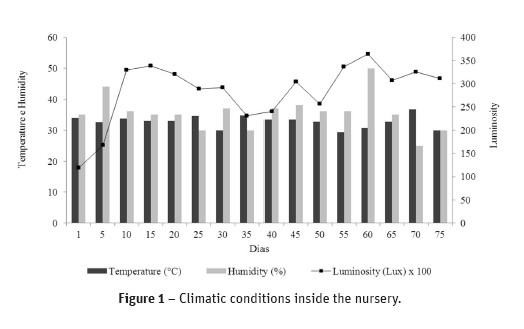
The experimental design was completely randomized with five replications and treatments arranged in a 5 x 4 factorial scheme. The treatments were constituted by samples of five soil classes representative of ecosystems from Southwest of Piauí (Table 1) collected in areas of native vegetation at a depth of 0.2 m and four N treatments (a-inoculation with strain BR 4406 Bradyrhizobium elkanii authorized Ministry of Agriculture, Livestock and Supply for E. contortisiliquum,b- with application of mineral N, c- with mineral N and inoculation with BR 4406 e d-without mineral N and inoculation).

The soils samples were air dried, passed through a 2-mm sieve and put in polystyrene bags of 2 kg. The chemical characteristics of soils samples evaluated in the 0.2 m layer are shown in Table 2.
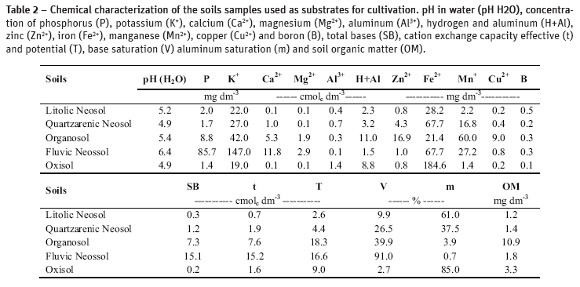
Seeds were treated with concentrated sulfuric acid for 30 minutes and disinfected with 10% sodium hypochlorite for 1 minute before seeding. The inoculant with strain BR 4406 was prepared with autoclaved peat and a log phase culture (after six days of growth with a concentration of 109 cells g-1 inoculant) in semi-solid 79 medium (Fred and Waksman, 1928) in the proportion 3:1. Seeds were inoculated with the inoculant in the proportion 500 g/50 kg seeds. Four seeds per bag were sown immediately after inoculation. For the treatments with mineral nitrogen (urea) 150 mg per plant were applied in liquid form. Thinning was performed 15 days after sowing, leaving two plants per bag. Water was supplied twice a day to maintain humidity around 60% of the maximum water-holding capacity.
Seventy five days after sowing, the following variables were analyzed: number of nodules (NN), nodules fresh biomass (NFB), plant height (H), collar diameter (CD), the H/CD ratio, shoot dry biomass (SDB), root dry biomass (RDB), total dry biomass (TDB), the SDB/RDB ratio, the Dickson quality index (DQI), nitrogen accumulation in the shoots (NSDB) and efficiency compared to control with mineral N without inoculation (EFN). To measure dry biomass the nodules, shoots and roots were dried in an oven with forced air at 60º C until constant weight. The content of N was determined in shoot dry biomass by the semi-micro-Kjeldahl method and NSDB was calculated by multiplying SDB by N percentage and dividing by 100. The relative efficiency (EFN) of each treatment was calculated using the following formula: EFR = (treatments SDB) x 100/(SDB treatment with mineral N without inoculation). The DQI was determined according to Dickson et al. (1960), wherein DQI = TDB (g) / [(H (cm) / CD (mm) + RDB (g) / SDB (g)].
Data were subjected to analysis of variance and the means were compared by the Scott-Knott test at a probability level of 5% using the statistical program SISVAR 5.3 (Ferreira, 2011). Data of NN and NFB were transformed by square root of Y + 0.5.
Results and Discussion
There was a significant interaction between soils and nitrogen treatments for variables NN, H, H/CD and SDB/RDB, but not for EFN and CD (Table 3).
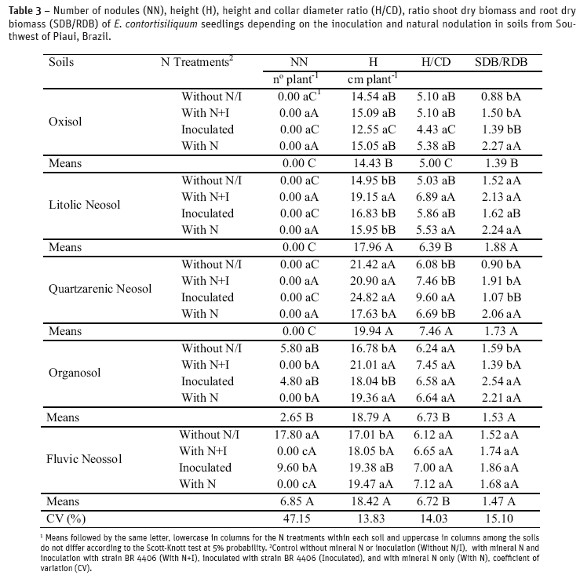
Nodulation occurred only in the Organosol and Fluvic Neossol. The largest NN (17.80 nodules plant-1) was obtained in the control without mineral N or inoculation in the Fluvic Neossol, indicating the presence of native populations of bacteria able to nodulate E. contortisiliquum. In the same soil, there was a significant reduction of NN following inoculation with strain BR 4406, suggesting a competition between native populations and inoculant strain, resulting in a lower nodulation. In the Organosol, the NN in the inoculated treatment was similar to the control without mineral N and inoculation (Table 3). The populations of nitrogen fixing bacteria that nodulate legumes, as well as selected inoculants are affected by various biotic and abiotic soil factors, such as chemical and physical attributes, the presence of the host plant, history of cultivation and management, among others (Jesus et al., 2009; Silva et al., 2009; Moreira et al., 2010). The reduction, maintenance and total inhibition of nodulation in inoculated treatments, compared to the other treatments can be attributed to these factors.
In both soils where nodulation occurred (Organosol and Fluvic Neossol), the treatments with mineral N did not nodulate, indicating the inhibitory role of this nutrient on nodulation of E. contortisiliquum.
There are several studies showing the inhibition of nodulation by high doses of mineral N (Silva et al., 2009; Costa et al., 2011). On the other hand, the use of small doses of N can improve plant growth and promote a synergistic effect on nodulation of some legumes species which have delayed nodulation or fix N2 during short periods of their cycle, such as Phaseolus vulgaris (Moura et al., 2009) and Inga maginata (Gonçalves et al., 1999). This fact was not observed for E. contortisiliquum in this work.
The absence of nodulation in Oxisol, Litolic Neosol and Quartzarenic Neosol may be related to low natural fertility as indicated by the low base saturation and high aluminum saturation (Table 2), that may have affected the survival and infection of bacteria in the roots. According to Bonilla and Bolaños (2010), soil nutritional deficiency can limit nodulation and biological nitrogen fixation (BNF).
The greater height (H) obtained in the treatment with inoculation was observed when plants were grown in Quartzarenic Neosol (24.82 cm plant-1), compared with other soils, despite an absence of nodulation in this soil. According to some studies, diazotrophic bacteria in addition to being responsible for the process of BNF, can also benefit plants by releasing plant growth promoting substances and solubilizing inorganic phosphate (Marra et al., 2011; Costa et al., 2013; Oliveira-Longatti et al., 2013) increasing thereby the development and vigor of seedlings.
In controls with and without mineral N the greater height of plants was obtained on Organosol, Quartzarenic Neosol and Fluvic Neosol soils. In the treatment with mineral N and inoculated with the strain BR 4406 seedlings produced in Oxisol showed significantly lower height compared to plants in the others soils (Table 3).
The ratio H/CD represents an important characteristic for the adaptation of seedlings in the field because it is related to growth equilibrium of these two important parameters (Gomes et al., 2002). According to Carneiro (1995), this ratio should be in the range 5.4 to 8.1; considering the overall mean of H/DC, only the seedlings grown in Oxisol did not fit within these limits. Among N treatments there was a significant difference only for the seedlings grown in Quartzarenic Neosol, being the highest value observed in treatment with inoculation only (Table 3). In the study by Melo et al. (2008) H/CD values within the range (5.4 to 8.1) were also obtained for E. contortisiliquum seedlings.
The SDB/RDB ratio is of fundamental importance for the organization and functioning of physiological processes and development of plants (Leles et al., 2000), being indicated as an efficient index to assess the quality of seedlings. The treatments with mineral N, with mineral N and inoculation and the control without mineral N or inoculation had no significant differences among soils for SDB/RDB (Table 3). For the treatment with inoculation only, plants grown in Fluvic Neosol and Organosol presented significantly higher values (Table 3). Marques et al. (2009) obtained values of SDB/RDB ranging from 3.41 to 1.37 for Piptadenia gonoacantha JF Macbr. seedlings grown in Argisol and Cambisol, respectively.
The variables NFB, RDB, TDB, DQI and NSDB were influenced by different soils and also by N treatments (Table 4). Seedlings grown in Fluvic Neossol has higher NFB (Table 4), indicating a higher occurrence of diazotrophic symbiotic bacteria in this soil. The control without mineral N and inoculation had the highest value of NFB, compared to other treatments.
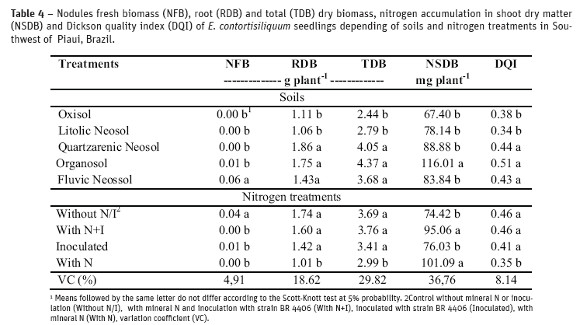
For RDB and TDB similar responses were observed in all soils, well as for the N treatments (Table 4). The seedlings grown in Quartzarenic Neosol, Fluvic Neossol and Organosol soils, showed higher mean than those grown obtained in Litolic Neosol and Oxisol soils. The lower means of RDB and TDB in Oxisol and Litolic Neosol soils can be attributed to fertility limitations of these soils (Table 2). According to Furtini Neto et al. (1999), the high aluminum saturation and low nutrient availability, especially of Ca2 + and Mg2 + are limiting factors for growth of forest species.
The highest NSDB was obtained when seedlings were grown on Organosol, with no significant differences in other soils (Table 4). It is important to consider that the Organosol had the highest content of organic matter (Table 2), probably leading to a large amount of N derived from mineralization during the experimental period and hence a higher concentration of this nutrient. Among N treatments, the highest NSDB was obtained in treatments with mineral N (with or without inoculation). The treatment inoculated with strain BR 4406 and the control without mineral N or inoculation showed similar means, indicating that inoculation with BR 4406 strain did not affect the NSDB compared to the native bacteria populations that nodulate E. contortisiliquum, agreeing with Sousa et al. (2013).
The DQI is an important morphological index because it translates the vigor and balance in distribution of plant biomass (Melo et al., 2008). For this index the seedlings grown in Quartzarenic Neosol, Organosol and Fluvic Neossol presented values significantly higher than in other soils (Table 4), suggesting that these soils are more suitable for the initial growth of E. contortisiliquum seedlings. Among N treatments, only the treatment with mineral N showed a DQI significantly lower than the others (Table 4).
There was a significant effect of soils on SDB (Table 5). Similarly to the results of RDB and TDB, the higher dry biomass of shoots was observed in seedlings grown in Quartzarenic Neosol, Organosol and Fluvic Neossol (Table 5). This can be attributed to better fertility of these soils (Table 2).
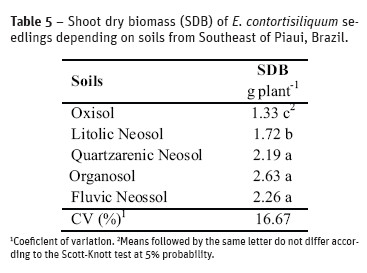
There was a significant effect of N treatments on EFN. The highest efficiency was observed in the treatment with mineral N and inoculation, while there were no significant differences among the other N treatments (Table 6).
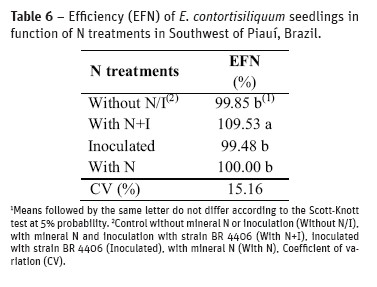
The symbiosis between plants and nitrogen fixing bacteria resulting in largest acquisition of N may stimulate the establishment and survival of seedlings inoculated in nursery phase and cultivated in the field. In some plants species, it is expected that inoculated plants will grown more than when uninoculated or even present a growth equal to N fertilized plants. This fact was not observed in this study and it may be attributed to differences between the chemical conditions of the soils, as well as the naturally occurring bacteria that nodulate E. contortisiliquum in the Organosol and Fluvic Neossol.
This inoculant strain (BR 4406) authorized by Ministry of Agriculture, Livestock and Supply showed poor adaption to the soil conditions from Southwest of Piauí, as it did not provide greater relative efficiency and nitrogen concentration in treatments that showed nodulation in the absence of nitrogen. It may also be noted that in Organosol and Fluvic Neossol there is a potential for isolation of efficient strains that may be tested as inoculants for E. contortisiliquum.
Conclusions
The E. contortisiliquum seedlings presented natural nodulation only when grown in Organosol and Fluvic Neossol soils.
The inoculant strain BR 4406 showed poor adaptation to the soils from Southwest of Piauí.
As the highest shoot and root dry biomasses and Dickson quality index were obtained in seedlings grown in Quartzarenic Neosol, Organosol and Fluvic Neossol, these soils are the best suited for the production of E. contortisiliquum seedlings.
References
Bala, A.; Murphy, P.J.; Osunde, A. O. and Giller, K.E. (2003) - Nodulation of tree legumes and the ecology of their native rhizobial populations in tropical soils. Applied Soil Ecology, vol. 22, n. 3, p. 211-223. [ Links ]
Bonilla, I. and Bolanos, L. (2010) - Mineral nutrition for legume-rhizobia symbiosis: B, Ca, N, P, S, K, Fe, Mo, Co, and Ni: A review. Organic Farming, Pest Control and Remediation of Soil Pollutants, vol. 1, p.253-274. [ Links ]
Brasil. Ministério da Agricultura, Pecuária e Abastecimento. Instrução normativa nº 13, p 03, [citado 2011-12-12]. Disponível em: http://www.agricultura.gov.br. [ Links ]
Carneiro, J.G.A. (1995) - Produção e controle de qualidade de mudas florestais. Curitiba: UFPR: FUPEF; Campos: UENF, 451p. [ Links ]
Costa, E.M.; Nóbrega, R.S.A.; Carvalho, F.; Trochmann, A.; Ferreira, L.V.M. and Moreira, F.M.S. (2013) - Promoção do crescimento vegetal e diversidade genética de bactérias isoladas de nódulos de feijão-caupi. Pesquisa Agropecuária Brasileira, vol. 48, n. 9, p. 1275-1284. [ Links ]
Costa, E.M.; Nóbrega, R.S.A.; Martins, L.V.; Amaral, F.H.C. and Moreira, M.F.S. (2011) - Nodulação e produtividade de Vigna unguiculata (L.) Walp. por cepas de rizóbio em Bom Jesus, PI. Revista Ciência Agronômica, vol. 42, n. 1, p. 1-7. [ Links ]
Dickson, A.; Leaf, A. and Hosner, J.F. (1960) - Quality apraisal of white spruce and white pine seedling stock in nurseries. Forestry Chronicle, vol. 36, n. 1, p. 10-13. [ Links ]
Ferreira, D.F. (2011) Sisvar: a computer statistical analysis system. Ciência e Agrotecnologia, vol. 35, n. 6, p. 1039-1042. [ Links ]
Fred, E.B. and Waksman, S.A. (1928) - Laboratory manual of general microbiology. New York: McGraw-Hill Book, 143p. [ Links ]
Furtini Neto, A.E.; Resende, A.V.; Vale, F.R.; Faquin, V. and Fernandes, L.A. (1999) - Acidez do solo, crescimento e nutrição mineral de algumas espécies arbóreas, na fase de muda. Revista Cerne, vol. 5, n. 2, p. 1-12. [ Links ]
Gomes, J.M.; Couto, L.; Leite, H.G.; Xavier, A. and Garcia, S.L.R (2002) - Parâmetros morfológicos na avaliação da qualidade de mudas de Eucalyptus grandis. Revista Árvore, vol. 26, n. 6, p. 655-664. [ Links ]
Gonçalves, C.A.; Goi, S.R. and Jacob Neto, J. (1999) - Crescimento e nodulação de ingá marginata em resposta à adição de azoto, fósforo e inoculação com rizóbio. Floresta e Ambiente, vol. 6, n. 1, p. 118-126. [ Links ]
Jesus, E.C.; Marsh, T.L.; Tiedje, J.M. and Moreira, F.M.S. (2009) - Changes in land use alters the structure of bacterial communities in Western Amazon soils. The ISME Journal, vol. 3, n. 10, p. 1004-1011. [ Links ]
Leles, S.P.S.; Carneiro, J.G.A.; Barroso, D.G. and Morgado, I.F. (2000) - Qualidade de mudas de Eucalyptus spp. produzidas em blocos prensados e tubetes. Revista Árvore, vol. 24, n. 1, p. 13-20. [ Links ]
Lorenzi, H. (2008) - Árvores brasileiras: Manual de identificação e cultivo de plantas arbóreas nativas do Brasil. 5. Ed. Nova Odessa: Instituto Plantarum, 384p. [ Links ]
Leles, P.S.S.; Carneiro, J.G.A.; Barroso, D.G. and Morgado, I.F. (2009) - Crescimento de mudas de jacaré (Piptadenia gonoacantha J. F. Macbr.) em diferentes tipos de solos e fontes e doses de azoto. Revista Árvore, vol. 33, n. 1, p. 81-92. [ Links ]
Marra, L.M.; Oliveira, S.M; Soares, C.R.F.S. and Moreira,F.M.S. (2011) - Solubilisation of inorganic phosphates by inoculant strains from tropical legumes. Scientia Agrícola, vol. 68, n. 5, p. 603-609. [ Links ]
Melo, R.R.; Cunha,M.C.L.; Rodolfo Júnior, F. and Stangerlin, D.M. (2008) - Crescimento inicial de mudas de Enterolobium contortisiliquum (Vell.) Morong. sob diferentes níveis de luminosidade. Revista Brasileira de Ciências Agrária, vol. 3, n. 2, p. 138-144. [ Links ]
Moreira, F. M. S. and Siqueira, J.O. (2006) - Microbiologia e bioquímica do solo. 2a. ed. Lavras, UFLA, 729p. [ Links ]
Moreira, F.M.S.; Carvalho, T.S. and Siqueira, J.O. (2009) - Effects of fertilizers, lime, and inoculation with rhizobia and mycorrhizal fungi on the growth of four leguminous tree species in low-fertility soil. Biology and Fertility of Soils, vol.46, p.771-779. [ Links ]
Moura, J.B.; Guareschi, R.F.; Correia, A.R.; Gazolla, P.R. and Cabral, J.S.R. (2009) - Produtividade do feijoeiro submetido à adubação nitrogenada e inoculação com Rhizobium tropici. Global Science and Technology, vol. 2, n. 3, p. 66-71. [ Links ]
Nóbrega, R.S.A.; Paula, A.M.; Boas, R.C.V.; Nóbrega, J.C.A. and Moreira, F.M.S. (2008) - Parâmetros morfológicos de mudas de Sesbania virgata (Caz.) Pers e de Anadenanthera peregrina (L.) cultivadas em substrato fertilizado com composto de lixo urbano. Revista Árvore, vol. 32, n. 3, p. 597-607. [ Links ]
Oliveira-Longatti, S.M.; Marra, L.M.; L Soares, L.B.; Bomfeti, C.A.; Silva, K.; Avelar Ferreira, P.A.A. and Moreira, F.M.S. (2013) - Bacteria isolated from soils of the western Amazon and from rehabilitated bauxite-mining areas have potential as plant growth promoters. World Journal of Microbiology & Biotechnology, vol.29, p.1-12. [ Links ]
Schmitz, J.A.K.;Souza, P.V.D. and Kämpf, A.N. (2002) - Propriedades químicas e físicas de substratos de origem mineral e orgânica para o cultivo de mudas em recipientes. Ciência Rural, vol. 32, n. 6, p. 937-944. [ Links ]
Silva, E.F.L.; Miranda, J.M.S.; Araújo, A.S.F.; Carvalho, E.M.S. and Nunes, L.A.P.L. (2009) - Nodulação natural de leguminosas em solos de cerrado do estado do Piauí. Revista Brasileira Ciência Agrária, vol. 4, n. 3, p. 274-277. [ Links ]
Souchie, E.L.; Campello, E.F.C.; Saggin-Júnior, O.J. and Silva, E.M.R. (2005) - Mudas de espécies arbóreas inoculadas com bactérias solubilizadoras de fosfato e fungos micorrízicos arbusculares. Revista Floresta, vol. 35, n. 2, p. 329-334. [ Links ]
Sousa, W.C.; Nóbrega, R.S.A.; Nóbrega, J.C.A.; Brito, D.R.S.; Moreira, F.M.S. (2013) - Fontes de azoto e caule decomposto de mauritia flexuosa na nodulação e no crescimento de Enterolobium contortisiliquum. Revista Árvore, vol. 37, n. 5, p. 969-979. [ Links ]
Trannin, I.C.B.; Moreira, F.M.S. and Siqueira, J.O. (2001) - Crescimento e nodulação de Acacia mangium, Enterolobium contortisiliquum e Sesbania virgata em solo contaminado com metais pesados.Revista Brasileira de Ciência do Solo, vol. 25, p. 743-753. [ Links ]
Recebido/Received: 2013.12.14
Aceitação/Accepted: 2014.02.18














